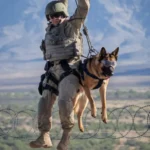The British Army’s Military Working Dogs recently elevated their combat readiness by taking flight during a major NATO exercise in Estonia.

As part of Exercise Steadfast Defender 24, patrol dogs from the 1st Military Working Dog Regiment (1 MWD) experienced helicopter flights to enhance their adaptability on the battlefield, a critical step in preparing for real-world combat scenarios.
Lieutenant Lucy Hardingham, a veterinary officer with 1 MWD, emphasized the importance of exposing dogs to the unfamiliar sights and sounds of military vehicles, especially helicopters.
This “battle inoculation” prepares the dogs to remain calm and effective in stressful environments. By familiarizing the dogs with these unusual conditions, the Army ensures they can focus on their mission when it matters most.
During the exercise, the dogs worked alongside British, US, and Polish paratroopers, utilizing their keen senses to detect enemy forces.
Their bark alone can deter aggression, while their strength and bite provide a non-lethal method to apprehend intruders. These dogs’ ability to support combat operations is critical to modern military tactics.
For handlers like Private Amelie Phillips, working with these highly trained animals is a partnership built on trust and rigorous training.
Phillips, the handler of a three-year-old German Shepherd named Davis, spoke proudly about how much effort it took to prepare for the exercise. Despite initial challenges, Davis has become a reliable partner, showcasing the close bond between handler and dog.
Lieutenant Hardingham also praised military working dogs as a “force multiplier,” highlighting the adaptability and dedication required to train and maintain their high standards.
The dogs’ fitness and capability are a testament to the dedication of both the dogs and their handlers.
Exercise Steadfast Defender 24 brought together over 90,000 troops from all 32 NATO allies, making it NATO’s largest military drill since the Cold War.
The exercise tested their ability to respond quickly and cohesively to crises, reinforcing the critical role military working dogs play in modern defense strategies.
Contents
Conclusion
The British Army’s commitment to enhancing the combat readiness of its military working dogs was on full display during NATO’s Steadfast Defender 24.
By exposing these dogs to unfamiliar environments like helicopter flights, the Army ensures they can handle the complexities of modern warfare.
The strong bond between handler and dog is essential to their success, and the dedication of both is clear. As NATO forces continue to evolve, military working dogs remain a crucial part of the team.
FAQs
- Why did the British Army train military dogs on helicopters? Exposing military dogs to helicopters helps them adapt to unfamiliar environments, ensuring they remain calm and effective during real combat situations.
- What role do military dogs play in battlefield operations? Military dogs use their keen senses to detect enemy forces and can act as a non-lethal deterrent with their bark or bite.
- What challenges did Private Amelie Phillips face with her dog Davis? Initially, Davis struggled with an “off switch” and was nervous around veterinary care, but through training, he became a reliable combat partner.
- What is the purpose of “battle inoculation” for military dogs? Battle inoculation prepares dogs for the stressful sounds and movements of military vehicles like helicopters, ensuring they stay focused during real missions.
- What is Exercise Steadfast Defender 24? Steadfast Defender 24 is NATO’s largest military exercise since the Cold War, involving over 90,000 troops from 32 countries, designed to test crisis response and reinforce European defenses.
- Why are military dogs considered a “force multiplier”? Military dogs enhance the effectiveness of operations, providing unique capabilities like enemy detection and non-lethal force, significantly boosting the unit’s overall performance.







